Off to Austin
 From Lafayette, LA to Austin, TX was (except for the first
day of the trip), the longest stretch of of driving on our itinerary.
I-10 through western Louisiana led past long stretches of swamp, occasionally
interrupted by a long, high bridge over a bayou. There were rice paddies around
Crowley, LA,
though we didn’t see any intensive cultivation going on. Many of the
houses near the paddies were built on short stilts. The flat, treeless area
felt desolate to us, though no doubt it feels different to the people who live there.
From Lafayette, LA to Austin, TX was (except for the first
day of the trip), the longest stretch of of driving on our itinerary.
I-10 through western Louisiana led past long stretches of swamp, occasionally
interrupted by a long, high bridge over a bayou. There were rice paddies around
Crowley, LA,
though we didn’t see any intensive cultivation going on. Many of the
houses near the paddies were built on short stilts. The flat, treeless area
felt desolate to us, though no doubt it feels different to the people who live there.
Occasionally we saw refineries and other structures apparently related to the oil industry; these sightings increased as we got into Texas. The weather was bright but hot and muggy, as one expects in that part of the world. Around Houston, under hazy skies, we encountered construction delays and plenty of traffic, but after we got past that and took US-290 toward Austin, things got pleasanter. The air was less humid and there was a nice breeze.
It seemed to be excellent weather for bugs, and we picked up multitudes of them on the front of the car and the windshield. Dorothea figured they must have turned out in droves for the mating season, but if so they chose a strange way to ensure the continuity of their DNA: diving to meet oncoming cars and perishing with a massive, gooey splat! on innocent windshields, turning the drivers behind them into mass murderers. When we stopped for gas, I scrubbed fiercely at the windshield to clear some of the mess. A man walking by called out cheerfully, “Better keep your mouth shut!”
The Hill Country landscape we were coming into was green and fresh after the steaming swampland we’d been driving through. Multitudes of small black-eyed Susans (or something that looked a lot like them) turned the roadsides and median gold; we also saw lots of coppery multicolored flowers that looked like tiny marigolds.
We reached Austin a little before four and plunged into thick traffic on I-35, where we were held up first by an accident and then, as soon as we got off the interstate, by construction along the frontage road we had to take to our motel. But we did get there at 4:30, feeling hot, tired, and a little wrung out.
That evening we had plans to meet two friends for dinner at Threadgill’s Restaurant. It was pretty far from the motel, so we indulged our travel-weariness by taking a taxi.
Jon and Craig, whom we had never met in person, jointly manage a website devoted to the life and writings of my late friend John Bellairs, and for the last couple of years I’ve been assisting them occasionally with information about our years at Notre Dame and about various bygone Catholic issues and folkways that pertain to John’s satirical book, Saint Fidgeta and Other Parodies. Craig lives near Austin and Jon near Dallas, and when I proposed this meeting I discovered that they had never before met in person. This made it a historic occasion for all of us.
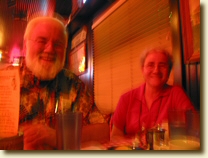 Threadgill’s is an Austin institution famous not only for
its vegetables but for its reasonable prices and casual décor. The room where
we ate had a bar and and was partially lit by neon beer signs, in the light of
which Craig took a rather atmospheric photo of Dorothea and me.
Threadgill’s is an Austin institution famous not only for
its vegetables but for its reasonable prices and casual décor. The room where
we ate had a bar and and was partially lit by neon beer signs, in the light of
which Craig took a rather atmospheric photo of Dorothea and me.
(In fairness to Threadgill’s, the lighting there is by no means as lurid as the camera’s reaction made it look. As for the portraits, I am always a little blurry after the second beer, but Dorothea has no good excuse.)
We had a most enjoyable meal with these two pleasant and intelligent young men, talking about ourselves, themselves, and of course John Bellairs and various mutual acquaintances (such as my ND classmates Al Myers and Phil Gibson, who have also helped with the website). I ate my first chicken-fried steak (with garlic cheese grits and black-eyed peas) and loved it. Dorothea ordered a combo of five of Threadgills’ famous vegetable dishes, though one she passed over is macaroni and cheese, which the menu annotates as follows: “Considered a vegetable in Oklahoma.”
Jon and Craig gallantly volunteered to save us the return taxi fare by driving us back to the motel, and we made only the faintest token efforts to resist this generous offer.
West Texas and the Circle Bar Spread
 We started toward West Texas on a
beautiful, clear, sunny morning with dry air and a cool breeze. Our escape from
Austin was accomplished pretty
easily — the motel was well placed for that at least — and we found US-290 even
easier going than on the previous day. I was surprised by the
willingness of Texas to post a
70-mph speed limit on a road to which access is not limited, but it appears to
work fairly well. The roads are mostly straight and very wide; visibility is good and traffic (by northeastern
standards) thin. As you approach a town the speed limit is reduced in stages,
then gradually built up again once you’re through.
We started toward West Texas on a
beautiful, clear, sunny morning with dry air and a cool breeze. Our escape from
Austin was accomplished pretty
easily — the motel was well placed for that at least — and we found US-290 even
easier going than on the previous day. I was surprised by the
willingness of Texas to post a
70-mph speed limit on a road to which access is not limited, but it appears to
work fairly well. The roads are mostly straight and very wide; visibility is good and traffic (by northeastern
standards) thin. As you approach a town the speed limit is reduced in stages,
then gradually built up again once you’re through.
We were still in the Hill Country for the first part of the trip. The ridges we saw gently rolling across the landscape were covered with tan grass and dotted with dark green trees and brush. White, yellow, and blue flowers were everywhere, although it was too late for the famous Texas bluebonnets. This was pecan country, and we also passed quite a few little stores advertising sausages and jerky.
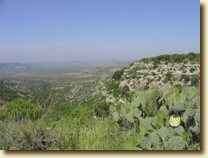 West of Fredericksburg, the land got drier and the hills
craggier. The grass and flowers thinned out, and rangy trees seemed to be
hanging onto the sandy soil. Road cuts exposed layers of tan sandstone, and
most of the small buildings we passed were built with it.
West of Fredericksburg, the land got drier and the hills
craggier. The grass and flowers thinned out, and rangy trees seemed to be
hanging onto the sandy soil. Road cuts exposed layers of tan sandstone, and
most of the small buildings we passed were built with it.
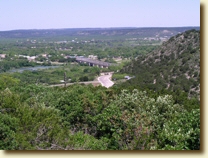 Twenty miles after rejoining I-10 (which runs through San
Antonio instead of Austin),
we stopped at Junction, TX, where (after visiting an overlook where we could
look down on the town and the valley of the Llano River) we located Cooper’s
BBQ Pit. My Internet research had suggested that this would be good, and it
was. Each of us had a sandwich filled with several slices (¼" thick or a
little less) of barbecued beef brisket, mesquite-smoked in the Texas style. In the rear of the restaurant were several open barbecue pits. They
weren’t fired up that early in the day, but plenty of cut wood was on hand.
Twenty miles after rejoining I-10 (which runs through San
Antonio instead of Austin),
we stopped at Junction, TX, where (after visiting an overlook where we could
look down on the town and the valley of the Llano River) we located Cooper’s
BBQ Pit. My Internet research had suggested that this would be good, and it
was. Each of us had a sandwich filled with several slices (¼" thick or a
little less) of barbecued beef brisket, mesquite-smoked in the Texas style. In the rear of the restaurant were several open barbecue pits. They
weren’t fired up that early in the day, but plenty of cut wood was on hand.
We had eaten a light motel breakfast and were hungry. The brisket was excellent, as was the BBQ sauce provided. The peach cobbler I finished off with was very good too.
Our motel, which we reached at about 2:30, was part of a complex named “Circle Bar Truck Corral” just outside the small town of Ozona. We were less than halfway to El Paso, but Dorothea’s brother George, whom we were on our way to visit, had suggested this as a good place to stop. The complex includes filling stations for cars, trucks, and RVs, an RV park, a truck repair facility, a restaurant, and a store that offers, besides the usual gift items, things that truckers find useful, like pads of forms.
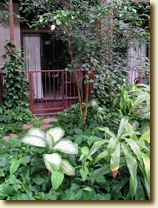 The motel itself is built around a big two-story atrium
containing two small swimming pools (one for tots) and a round Jacuzzi, set
among a gorgeous collection of green tropical plants, some of them tree-sized.
Each room on the motel’s two floors has a balcony opening onto this garden, as
well as a door to the outside of the building.
The motel itself is built around a big two-story atrium
containing two small swimming pools (one for tots) and a round Jacuzzi, set
among a gorgeous collection of green tropical plants, some of them tree-sized.
Each room on the motel’s two floors has a balcony opening onto this garden, as
well as a door to the outside of the building.
We weren’t tempted to swim — to be honest, we seldom are — and the outdoors, at least in the shade, was actually more comfortable than the atrium thanks to a cool breeze. The indoor tropical garden, because of the conditions that have to be maintained for the sake of the flora, was comparatively muggy. But, from the air-conditioned comfort of our room, we enjoyed the view through our sliding door. We used the afternoon to get some laundry done, lie around reading, and even to nap after the previous day’s long drive (and in anticipation of the next day’s).
Dinner was burgers and soda at the attached truck stop restaurant, which serves no alcohol (although George later told us that it used to do so, and was a pretty rowdy place in those days). After eating we took a turn around the motel watching the birds and wishing that we had brought the Sibley guide along, despite its bulk. There were noisy great-tailed grackles, twittering shrilly, and white-tailed doves that had a gravelly, sort of double-voiced call. The motel has a number of well-maintained trees on its grounds, and in the nearly treeless West Texas landscape these attract hordes of birds, in spite of owl decoys hung in a couple of them. In the early evening, swallows were swooping about the place in pursuit of bugs. I wished them well, preferring that if the bugs must perish, they do so inside the swallows rather than on our windshield. On the basis of the description I wrote down, I’m pretty sure that these were cliff swallows, even though Sibley’s map suggests that Ozona may in the small area of Texas where you can also see Mexican cave swallows. They look quite similar to cliff swallows, but are pretty rare in the US.
All the Way West in West Texas
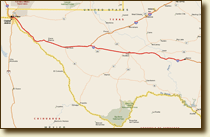 We filled the tank at the Circle Bar Truck Corral’s gas
station and headed west on I-10, departing from it once to take a “scenic loop”
past the site of Fort Lancaster. The sandy soil
in this part of West Texas was dotted with mesquite, prickly pear, yucca, and a
smallish evergreen that looked like a yew. In some places we could see little
oil pumps working away.
We filled the tank at the Circle Bar Truck Corral’s gas
station and headed west on I-10, departing from it once to take a “scenic loop”
past the site of Fort Lancaster. The sandy soil
in this part of West Texas was dotted with mesquite, prickly pear, yucca, and a
smallish evergreen that looked like a yew. In some places we could see little
oil pumps working away.
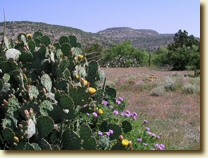 We stopped here and there to photograph interesting
flora. We seem to have concentrated on prickly pears — probably because we knew
what they were.
We stopped here and there to photograph interesting
flora. We seem to have concentrated on prickly pears — probably because we knew
what they were.
We had lunch in Fort Stockton (where, before we got George’s tip, we had planned to spend the previous night).
Near Bakersfield, where a series of mesas parallel the road, a wind farm has been built along the ridges. The white, three-bladed turbines turned slowly, looking quite graceful against the empty sky.
That single tank of gas might have been enough to take us all 350 miles of the way to El Paso, but on the other hand it might not have been, and we had been warned that filling stations were scarce along our route, so we topped up the tank at Van Horn. (This turned out to be a good thing, because in El Paso we landed in the midst of a traffic tieup and had to creep six or seven miles in first gear.)
The country grew increasingly hillier as we drove west until finally we were between mountains, and could see more and higher ones beyond them — although the road itself was free of steep climbs and tight curves. Between the road and the mountains were flat plains where we saw quite a few dust devils. At first we weren’t sure what these were, because the tight columns appeared to hover in one place longer than we thought natural for a whirlwind. But then we saw some arise and dissolve quickly, and we realized that the others were so far from us that they might have been moving more than they appeared to. During the last part of the trip the Rio Grande valley was on our left, but we caught only one tiny glimpse of water. Most of the time we could only tell where the river most likely was by the lay of the land and a little more green in the vegetation. We had now entered the Mountain Time Zone, which includes the far western corner of Texas.
It was late afternoon when we reached El Paso, and after grinding our way through the aforementioned traffic jam, got onto the northbound US-54 where we could speed up again. In spite of a little confusion in the directions (caused either by Microsoft Roads & Trips or by my misuse of the program), it didn’t take us long to find George and Nancy’s house, which is high on a hill with a long view towards the Guadalupe Mountains. Despite the view, we were happy to get inside, because the temperature — 70° when we left Ozona — had reached 97° or so while we were crawling through the traffic.
It was a nice change to stop being tourists for a while and just be George and Nancy’s guests. They identified the grackles and white-tailed doves we’d seen at Ozona from our descriptions. They have plenty of doves — to their annoyance, as the birds nest in the trees over the swimming pool, befouling it with their droppings and the debris they knock out of the branches.
We spent the next day lazing comfortably around the house, and in the evening went out to a restaurant called Forti’s Mexican Elder — the last two words refer to a type of tree, not a type of senior citizen — which had been one of George and Nancy’s favorites since their first arrival in El Paso. The food, typical Tex-Mex fare, was excellent. My combo platter included a tamal: the first time I had encountered this noun in the singular. Dorothea ordered chicken enchiladas for the first but not the last time. I drank Dos Equis and we all had flan for dessert.
In the morning, we exchanged goodbyes and got on the road to New Mexico.
This section last updated 12-13-2004
